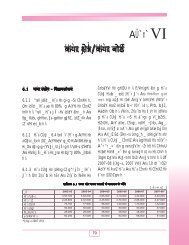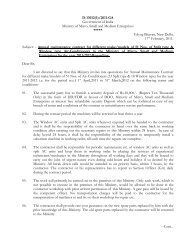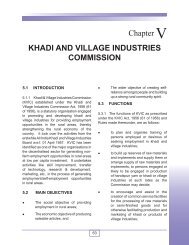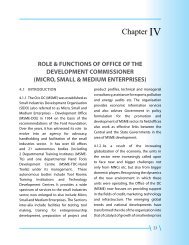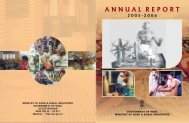Evaluation Study MSE Cluster Development - Ministry of Micro ...
Evaluation Study MSE Cluster Development - Ministry of Micro ...
Evaluation Study MSE Cluster Development - Ministry of Micro ...
Create successful ePaper yourself
Turn your PDF publications into a flip-book with our unique Google optimized e-Paper software.
Chapter No: 5– The Special Purpose Vehcileintervention. This process <strong>of</strong> selection must be devoid <strong>of</strong> subjective and politicalconsiderations that lead to the improper selection <strong>of</strong> the cluster and the subsequentfailure or lack <strong>of</strong> impact <strong>of</strong> the SICDP. This clearly highlights the importance <strong>of</strong> thediagnostic study and the proper selection and training <strong>of</strong> CDEs. These issues have beenmore elaborately treated in earlier chapters.The level <strong>of</strong> involvement or inclusiveness <strong>of</strong> the individual cluster actors in the SPVs isalso indicated and classified into two simple categories H and L. This has been compiledusing figures related to initial membership at the time <strong>of</strong> registration, presentmembership, the percentage change in membership, as well as the total number <strong>of</strong>individual cluster units in each <strong>of</strong> the clusters covered during the study.The involvement <strong>of</strong> cluster members depends on how keen and motivated they are onbeing a part <strong>of</strong> the SPV. There keenness will also depend on how aware they are <strong>of</strong> thebenefits <strong>of</strong> common facilities as compared to the risks and financial commitmentsinvolved. Initially there may be only a few who are willing to join however as thecommon facility project gets approved and starts to unfold more persons may beattracted to join the SPV. These late applicants may or may not be encouraged to joinas SPV members by the existing incumbents, even if such late admission involves asubstantially higher financial commitment in terms <strong>of</strong> share money. Moreover there maybe statutory upper limit on the number <strong>of</strong> shareholders permitted depending on theorganizational form adopted. In the case <strong>of</strong> a private limited company for instance thislimit is fixed at 49 members. However even this statutory limit can be extended to coverall cluster actors by allowing shares to be collectively held by “holding companies”formed by a group <strong>of</strong> individual cluster actors.The degree <strong>of</strong> involvement and inclusiveness will be high if a large numbers if not all theindividual members are shareholders in the SPV formed and registered. The degree <strong>of</strong>inclusiveness would be high if the existing members <strong>of</strong> the SPV encourage moremembers to join even at a later stage and constantly encourage enhanced involvementand participation by those who initially prefer to stay out but later do not want to missthe boat.In Table 5.1 we see that the level <strong>of</strong> involvement and inclusiveness varies among the 11SPVs covered during the study. In the case <strong>of</strong> 5 SPVs the involvement and inclusivenessis observed to be high. Four <strong>of</strong> these 5 SPVs are registered as societies while only one <strong>of</strong>them is registered as a private limited company. Not all these clusters that these SPVsrepresent are large, indicating that democratic participation, involvement andinclusiveness in a SPV does not really depend on whether the cluster is large or small butis certainly determined by the organizational form adopted by the SPV representing thecluster. In the case <strong>of</strong> 6 SPVs, the involvement and inclusiveness is low, among these 3are registered as private limited companies while the remaining three are registeredsocieties. Here again these SPVs represent, both large and small clusters, and so thesize <strong>of</strong> the cluster does not have much to do with explaining involvement andinclusiveness. However take the case <strong>of</strong> the Wet Grinder <strong>Cluster</strong> in Coimbatore havingas many as 700 individual units and thus a large and dense cluster making it most viableand sustainable yet surprisingly at the time <strong>of</strong> registration <strong>of</strong> its SPV as a society, as farback as 2005, it had only 30 members. To make matters worse, in 2008 March, when96





